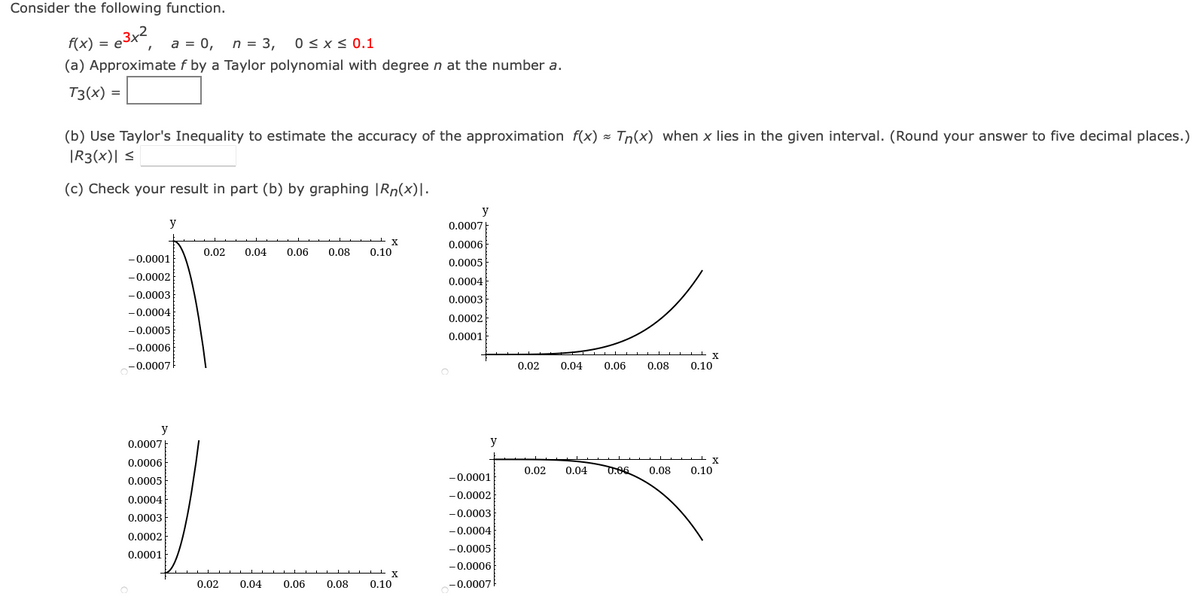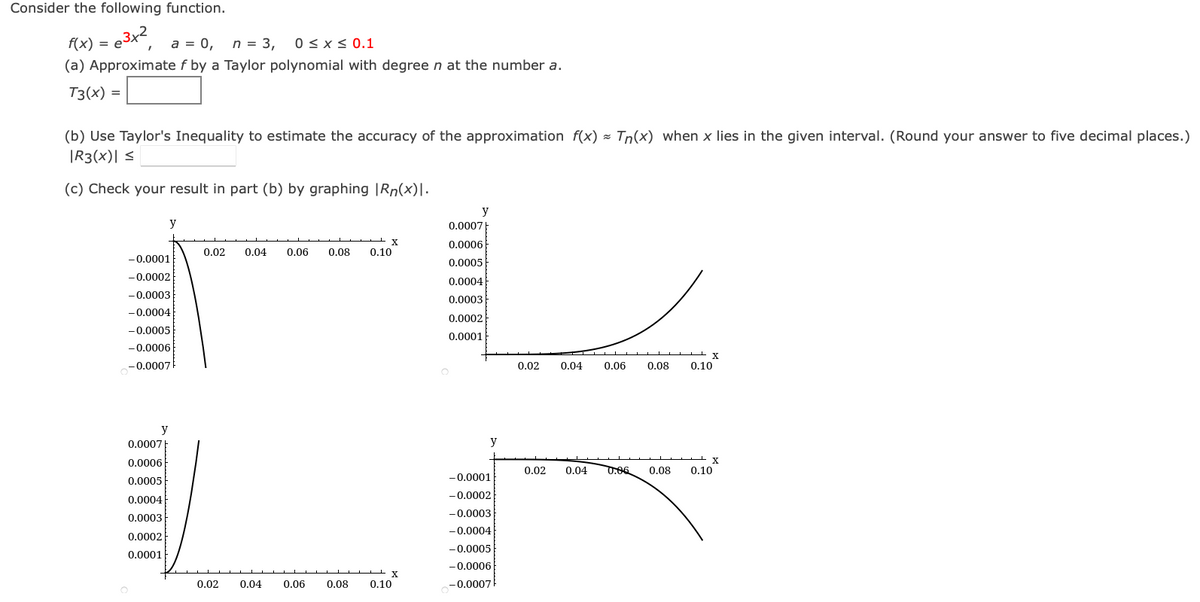Consider the following function. f(x) = e3x² a = 0, n = 3, 0 ≤ x ≤ 0.1 (a) Approximate f by a Taylor polynomial with degree n at the number a. T3(x) = (b) Use Taylor's Inequality to estimate the accuracy of the approximation f(x) = Tn(x) when x lies in the given interval. (Round your answer to five decimal places.) |R3(x)| ≤ (c) Check your result in part (b) by graphing |Rn(x)\. -0.0001 -0.0002 -0.0003 -0.0004 -0.0005 -0.0006 -0.0007 y y 0.0007 0.0006 0.0005 0.0004 0.0003 0.0002 0.0001 X 0.02 0.04 0.06 0.08 0.10 0.02 0.04 0.06 X 0.08 0.10 y 0.0007 0.0006 0.0005 0.0004 0.0003 0.0002 0.0001 y -0.0001 -0.0002 -0.0003 -0.0004 -0.0005 -0.0006 -0.0007 X 0.02 0.04 0.06 0.08 0.10 0.02 0.04 X 0.08 0.10 Consider the following function. f(x) = e3x² a = 0, n = 3, 0 ≤ x ≤ 0.1 (a) Approximate f by a Taylor polynomial with degree n at the number a. T3(x) = (b) Use Taylor's Inequality to estimate the accuracy of the approximation f(x) = Tn(x) when x lies in the given interval. (Round your answer to five decimal places.) |R3(x)| ≤ (c) Check your result in part (b) by graphing |Rn(x)\. -0.0001 -0.0002 -0.0003 -0.0004 -0.0005 -0.0006 -0.0007 y y 0.0007 0.0006 0.0005 0.0004 0.0003 0.0002 0.0001 X 0.02 0.04 0.06 0.08 0.10 0.02 0.04 0.06 X 0.08 0.10 y 0.0007 0.0006 0.0005 0.0004 0.0003 0.0002 0.0001 y -0.0001 -0.0002 -0.0003 -0.0004 -0.0005 -0.0006 -0.0007 X 0.02 0.04 0.06 0.08 0.10 0.02 0.04 X 0.08 0.10
Consider the following function. f(x) = e3x² a = 0, n = 3, 0 ≤ x ≤ 0.1 (a) Approximate f by a Taylor polynomial with degree n at the number a. T3(x) = (b) Use Taylor's Inequality to estimate the accuracy of the approximation f(x) = Tn(x) when x lies in the given interval. (Round your answer to five decimal places.) |R3(x)| ≤ (c) Check your result in part (b) by graphing |Rn(x)\. -0.0001 -0.0002 -0.0003 -0.0004 -0.0005 -0.0006 -0.0007 y y 0.0007 0.0006 0.0005 0.0004 0.0003 0.0002 0.0001 X 0.02 0.04 0.06 0.08 0.10 0.02 0.04 0.06 X 0.08 0.10 y 0.0007 0.0006 0.0005 0.0004 0.0003 0.0002 0.0001 y -0.0001 -0.0002 -0.0003 -0.0004 -0.0005 -0.0006 -0.0007 X 0.02 0.04 0.06 0.08 0.10 0.02 0.04 X 0.08 0.10 Consider the following function. f(x) = e3x² a = 0, n = 3, 0 ≤ x ≤ 0.1 (a) Approximate f by a Taylor polynomial with degree n at the number a. T3(x) = (b) Use Taylor's Inequality to estimate the accuracy of the approximation f(x) = Tn(x) when x lies in the given interval. (Round your answer to five decimal places.) |R3(x)| ≤ (c) Check your result in part (b) by graphing |Rn(x)\. -0.0001 -0.0002 -0.0003 -0.0004 -0.0005 -0.0006 -0.0007 y y 0.0007 0.0006 0.0005 0.0004 0.0003 0.0002 0.0001 X 0.02 0.04 0.06 0.08 0.10 0.02 0.04 0.06 X 0.08 0.10 y 0.0007 0.0006 0.0005 0.0004 0.0003 0.0002 0.0001 y -0.0001 -0.0002 -0.0003 -0.0004 -0.0005 -0.0006 -0.0007 X 0.02 0.04 0.06 0.08 0.10 0.02 0.04 X 0.08 0.10
College Algebra
7th Edition
ISBN:9781305115545
Author:James Stewart, Lothar Redlin, Saleem Watson
Publisher:James Stewart, Lothar Redlin, Saleem Watson
Chapter3: Polynomial And Rational Functions
Section3.6: Rational Functions
Problem 2E
Related questions
Question

Transcribed Image Text:Consider the following function.
f(x) = e3x²
a = 0, n = 3, 0 ≤ x ≤ 0.1
(a) Approximate f by a Taylor polynomial with degree n at the number a.
T3(x) =
(b) Use Taylor's Inequality to estimate the accuracy of the approximation f(x) = Tn(x) when x lies in the given interval. (Round your answer to five decimal places.)
|R3(x)| ≤
(c) Check your result in part (b) by graphing |Rn(x)\.
-0.0001
-0.0002
-0.0003
-0.0004
-0.0005
-0.0006
-0.0007
y
y
0.0007
0.0006
0.0005
0.0004
0.0003
0.0002
0.0001
X
0.02 0.04 0.06 0.08 0.10
0.02 0.04
0.06
X
0.08 0.10
y
0.0007
0.0006
0.0005
0.0004
0.0003
0.0002
0.0001
y
-0.0001
-0.0002
-0.0003
-0.0004
-0.0005
-0.0006
-0.0007
X
0.02 0.04 0.06 0.08 0.10
0.02 0.04
X
0.08 0.10

Transcribed Image Text:Consider the following function.
f(x) = e3x²
a = 0, n = 3, 0 ≤ x ≤ 0.1
(a) Approximate f by a Taylor polynomial with degree n at the number a.
T3(x) =
(b) Use Taylor's Inequality to estimate the accuracy of the approximation f(x) = Tn(x) when x lies in the given interval. (Round your answer to five decimal places.)
|R3(x)| ≤
(c) Check your result in part (b) by graphing |Rn(x)\.
-0.0001
-0.0002
-0.0003
-0.0004
-0.0005
-0.0006
-0.0007
y
y
0.0007
0.0006
0.0005
0.0004
0.0003
0.0002
0.0001
X
0.02 0.04 0.06 0.08 0.10
0.02 0.04
0.06
X
0.08 0.10
y
0.0007
0.0006
0.0005
0.0004
0.0003
0.0002
0.0001
y
-0.0001
-0.0002
-0.0003
-0.0004
-0.0005
-0.0006
-0.0007
X
0.02 0.04 0.06 0.08 0.10
0.02 0.04
X
0.08 0.10
Expert Solution
This question has been solved!
Explore an expertly crafted, step-by-step solution for a thorough understanding of key concepts.
Step by step
Solved in 3 steps with 3 images

Recommended textbooks for you

College Algebra
Algebra
ISBN:
9781305115545
Author:
James Stewart, Lothar Redlin, Saleem Watson
Publisher:
Cengage Learning

College Algebra
Algebra
ISBN:
9781305115545
Author:
James Stewart, Lothar Redlin, Saleem Watson
Publisher:
Cengage Learning